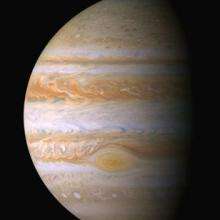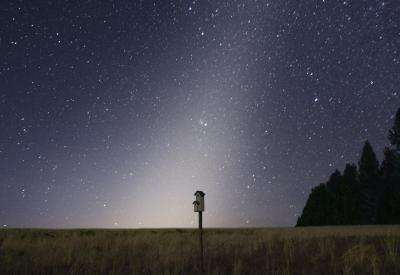STAR TRAK for February 2011

Jupiter will be the only bright planet visible as evening twilight fades during February, coming into view in the southwest. At mid-northern latitudes, this will be the last month until July when Jupiter will be high enough in the sky for good observing with a telescope. Binoculars will show Jupiter's four brightest moons clustered to the east of the planet on Feb. 5, and again to the planet's west on Feb 18.
About an hour after Jupiter sets, Saturn will rise in the east around 10:30 p.m. local time at the beginning of February and two hours earlier at month's end. It will remain in view the rest of the night, reaching its highest point in the south a few hours after midnight. Saturn will easily outshine the bright white star Spica to its left (south). The tilt of its rings will narrow slightly this month, but they will still be 10 degrees to our line of sight.
Saturn's largest moon, the planet-sized Titan, can be seen with any telescope on a clear night. Titan will be due south of Saturn on Feb. 12 and 28 and due north of the planet on Feb. 5 and 21. See saturn.jpl.nasa.gov/home/index.cfm for the latest news and images from the Cassini spacecraft orbiting Saturn.
Venus will rise more than two hours before the sun during February, blazing low in the southeast while the sky is still completely dark. The brilliant planet will pass several bright objects in the constellation Sagittarius the Archer this month.
Mercury will be very low in the southeast a half hour before sunrise during the first few days of February. It will appear even lower each morning, and observers in the Northern Hemisphere will soon lose sight of it in the brightening sky as it passes behind the sun.
Mars will also be out of sight behind the sun during February.
Zodiacal light
If you live in an area that is dark enough for you to see the Milky Way sprawling across the night sky, you also have a chance of seeing the interplanetary dust in the plane of our solar system. Find an open area with no light pollution or moonlight. After sunset as darkness falls, look for a faint pyramid of light spreading upward from the western horizon over a large area of the sky. This is the zodiacal light, which is sunlight reflected from microscopic debris left behind by comets and asteroids that orbit the sun in the same plane as the planets. An example can be seen below (from astrophoto.com):

Moon phases
The moon will be new on Feb. 2, at first quarter on Feb. 11, full on Feb. 18 and at third quarter on Feb. 24.
Provided by Indiana University





















